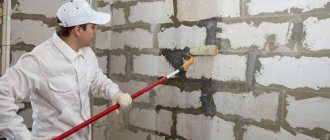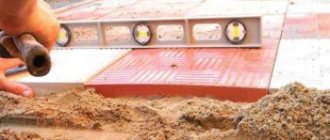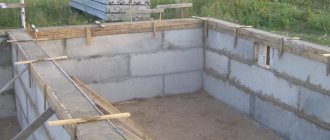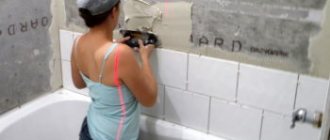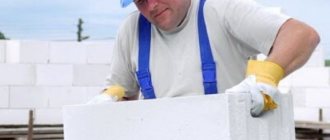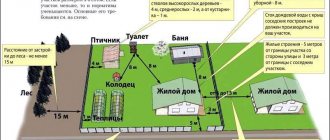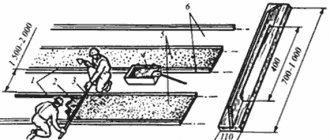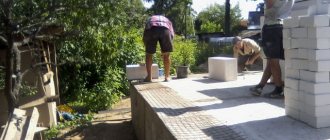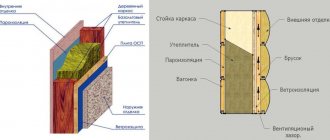What kind of solution are foam blocks placed on to get a strong structure?
From the author: Hello, dear visitors of our construction portal!
Recently, the construction of houses from various types of cellular concrete has become increasingly popular. One of the most common and convenient materials used for this purpose is foam concrete. Since this material is relatively new, not everyone knows its characteristics, advantages and principles of working with it. Therefore, we decided to dedicate today’s article to this information.
In it we will analyze in detail what kind of solution foam blocks are placed on, what nuances need to be taken into account when working, and why it is generally worth using this material for the construction of your future home or other structure.
We will start with brief information about what foam blocks are and what characteristics they have.
Characteristics of foam blocks
Even at the beginning of the twentieth century, developing construction required new materials that would be of higher quality than those existing at that time. Manufacturing and science struggled to meet consumer demands.
In the end, their efforts were crowned with success, and a completely new thing entered the market, which was immediately dubbed “miracle concrete.” I must say that at that time it was really good in comparison with its competitors. Of course, now, from the heights of the twenty-first century, we understand that its characteristics were far from miraculous.
However, it immediately occupied a fairly large space in the construction market. The rapidly gaining popularity, as well as the growing needs of customers, led to the fact that increased attention was paid to the development of the production of miracle concrete.
Manufacturers began experimenting, trying to achieve higher and higher levels of strength, water resistance and other important characteristics. The experiments were successful, and now we can see on the construction market many varieties of cellular concrete, each of which surpasses its ancestor in its qualities.
One of these variations is foam concrete. He inherited the main ingredients from his parent: sand, water and cement. That is, in essence, it would be ordinary concrete, if not for one nuance. During the production process, a special, fluffy foam is added to the mixture of main ingredients.
Thanks to this, the finished material has a very porous structure. What does this give us? Many different advantages.
Advantages
The main one is water resistance. It would seem that many holes in the structure of the blocks should lead to constant ingress and exposure to water. However, the manufacturing technology is designed in such a way that all pores are sealed.
That is, every air bubble inside the block is securely closed from moisture. This is a very important quality. If we take for comparison another type of cellular concrete - gas silicate blocks - then we can see a completely different picture. Aerated concrete is filled with through pores. Therefore, it absorbs water like a sponge, not only during precipitation, but also simply from the air.
As a result, without special treatment and finishing, walls made from it quickly begin to collapse. Freezing temperatures have a particularly detrimental effect. Water that penetrates the pores freezes and expands, thereby damaging the structure of the surrounding material.
And foam concrete, thanks to its production technology and its resulting structure, perfectly withstands exposure to any amount of water.
The next remarkable factor is the low weight of the material. Since foam concrete contains a large amount of air, the blocks are quite light. This makes them easy to work with. It is also very profitable to transport the material.
Let us briefly list other advantages:
- frost resistance - depending on the brand, the material can withstand 35–75 cycles of freezing and subsequent thawing. This indicator is very good and distinguishes foam concrete from the same aerated concrete with which it is often compared;
- resistance to fire - in the event of a fire, foam concrete walls can withstand about three or four hours of direct contact with flames. Often this time is just enough for the fire brigade to arrive and deal with the fire. Thus, the material has a direct impact on saving the house;
- good ability not to transmit heat - thanks to the same porous structure, foam concrete is a real high-quality barrier to warm air. If you are going to build a house in some cold region, which is characterized by long frosty winters, then it will be enough to build walls only half a meter thick. And in this case you won’t even need an additional insulating layer; foam concrete blocks will do an excellent job of retaining heat in the room on their own;
- environmental friendliness - since the material is based on natural ingredients (sand, water and cement), you don’t have to worry about the harmful effects on the environment and on the people who will live in a house built from foam concrete.
Flaws
Of course, there were some downsides too. The first and most important depends, oddly enough, not on the qualities of the material itself, but on the dishonesty of some people.
The fact is that the production technology is very simple. Therefore, it is accessible to many people. The cost of the material is quite low; the construction industry has sufficient demand for it. All this has led to high competition among manufacturers.
And while some in such cases strive to improve the quality of the material as much as possible in order to attract consumers, others take a different route and simply lower the price. And in order for production to pay for itself, they begin to save on initial components and other manufacturing nuances. That is, in the end we get low cost at the expense of quality.
This has led to the fact that at the moment it is very easy to “run into” material of very low quality. Therefore, we recommend purchasing it only from those suppliers and manufacturers who have long and reliably proven themselves in the building materials market.
The second disadvantage is that blocks made of foam concrete look unsightly, masonry made from them does not evoke aesthetic delight, and therefore necessarily requires finishing. On the other hand, you get a lot of opportunities to diversify the appearance of your home. So this minus can be left almost behind the scenes.
Choice of solution
Of course, all the listed advantages of foam concrete will only matter if the masonry work is carried out correctly. Agree, there is little point in the strength of the blocks themselves if they fall apart from each other within a month after construction is completed. That is why it is so important to know what kind of solution is needed for masonry.
Glue mixture
In building materials stores you can find special compounds for working with cellular concrete. This is an adhesive mixture that can be used for laying foam blocks, aerated concrete, and other types.
Such tools have several advantages:
- the amount of glue consumed is very small - the thickness of the seams varies within 2-3 millimeters. Firstly, it is economical, and secondly, it looks quite neat. If you are subsequently going to use plaster or other similar material as a finishing material, then it will be quite easy to mask all the imperfections in the appearance of the masonry;
- the glue dries quickly, so the speed of work is quite high, since you do not need to wait several days for every few rows to “set”, as is the case with cement;
- the strength of the masonry is very high. In addition, subsequent shrinkage is almost invisible, which is very convenient;
- you can choose a product taking into account individual needs - for example, with additives that give the glue frost-resistant qualities;
- working with glue is much cleaner; it doesn’t leave a lot of dirt behind, like cement does.
Of course, there are also disadvantages. The first is the price. The cost of adhesives is quite high. This factor is slightly compensated by the low consumption of material, but, nevertheless, construction is still more expensive than when using cement.
The second one smoothly follows from this same minus. It only makes sense to use masonry adhesive if the blocks are of high quality, in particular, if they have a smooth surface. If there are noticeable distortions, recesses, etc., then all this will have to be filled with masonry compound. That is, in this case - glue. Considering the high cost, this can cost a pretty penny.
Cement
In conversations with novice builders, I often, to my surprise, heard the question of whether it is possible to lay foam blocks on a cement-sand composition. Of course you can, why not? Cement is a reliable thing; it has firmly established itself in construction work, and it has done so for so long that there is simply no point in doubting it.
Another thing is that working with it is somewhat more difficult than with an adhesive composition, especially for those who are new to the construction of houses and other buildings. But, as soon as you get the hang of it, you will have an excellent opportunity to produce masonry both efficiently and inexpensively. In terms of cost, cement significantly outperforms adhesive compositions.
For this reason, it can also be used to work with uneven blocks. It is suitable for filling joints and for correcting any imperfections on the masonry surface. In general, the material is full of advantages: it holds blocks together perfectly, serves for a long time and reliably, and is cheap.
Several disadvantages can be noted:
- working with cement compositions is classified as “dirty”; even with the most careful handling, do not expect cleanliness;
- It hardens for a long time, so after laying several rows you have to interrupt work and wait a day. This slows down the process significantly, especially in the case of small walls;
- the composition cannot be used at air temperatures below zero, and even antifreeze additives will not help here;
- If you compare the amount of cement and adhesive composition used for the same amount of work, it is immediately clear that much more cement is needed. This means that mixing and placing will require a lot more space.
But despite all these disadvantages, most builders still prefer to use cement-sand mortar for laying foam blocks. And you can choose another option - it all depends on your needs, budget and other nuances. We wish you good luck in all your construction endeavors!
How to lay foam block on glue
One of the fastest and most economical ways to install foam blocks is to attach them with glue. The technology of applying the composition and its quality determine the strength of the entire object.
Foam block is a cellular material with high thermal insulation properties. However, when fastening blocks of material with a regular solution, all the protective properties of the material are reduced significantly. If you fasten the walls of an object with mortar, it will need additional insulation, which will lead to high costs. A building made of foam blocks, erected using special glue, does not require expensive thermal insulation materials.
Types and composition of adhesives
Adhesive compositions for porous materials are produced from dry substances consisting of the following components:
- Portland cement. Thanks to this substance, the glue becomes durable after drying. In addition, it is Portland cement that ensures rapid hardening of the composition.
- Modifiers. Substances are added to the mixture to increase its hydrophilic properties. They retain moisture in the seams, preventing them from drying out.
- Sand. Quartz particles give the composition strength, which allows for seams between blocks of up to 3 mm.
- Polymers. The elasticity of the mass is achieved precisely due to the presence of polymer in the composition. Thanks to the plasticity of polymers, the adhesive fills the voids of the material, improving the strength of the connection.
Almost all adhesive compositions contain the above components. The recipe and number of inclusions differ among different manufacturers.
Based on their properties, adhesives for foam blocks are divided into:
- Winter. The compositions are created specifically for use at low temperatures. This glue can be applied at temperatures from 5 to -10˚C. The peculiarity of winter glue is that it dries very quickly. Therefore, when working, the composition is mixed in small portions and immediately applied to the surface. Adhesion at low temperatures is ensured by the presence of antifreeze components in the composition. You need to dilute the glue with hot water 55-60˚C.
- Summer. The operating temperature of the glue ranges between 5 and 35˚C. The mixture remains in working condition for one and a half to two hours, during which time it must be applied, otherwise it will harden. The main component of summer glue is fine cement.
Note! When mixing glue for foam blocks, you must strictly follow the dilution proportions indicated on the packaging. By maintaining the ratio of liquid to powder, you can achieve the best consistency of the composition. You should not rely on intuition in such matters. Glue that is not diluted according to the recipe will not meet the declared qualities.
How to choose the best glue for foam blocks
It is not difficult to calculate the amount of glue per square meter of surface; it is much more difficult to choose a high-quality composition. The choice of such solutions is very large, so purchasing a suitable composition is not easy. When purchasing glue for foam blocks, it is worth remembering the following recommendations:
- The cheapness of the composition may indicate that low-quality components were used for its production. Therefore, you should not be guided by low cost; as a rule, cheap adhesives are made with the addition of coarse sand.
- Between a new and a well-known brand, it is better to choose the second one. Large companies sometimes provide a guarantee on their formulations. The main thing is that large enterprises carry out strict quality control and the entire process is automated.
- Decide on working hours in advance. If the installation will be carried out during the cold season, glue for the foam block with frost-resistant inclusions is required.
- It is better to purchase the composition with a reserve of 20-30 kg. During the laying process, much more glue may be used than planned.
When constructing a building from foam blocks, it is important to maintain a balance in the thickness of the seam. Do not try to save on the mixture, because too thin a layer will not create sufficient adhesion of the material, which can cause destruction.
Well-known manufacturers of mounting adhesive
Construction from foam blocks has been popular for many years, so the range of adhesives for the material is quite rich. According to reviews, the following brands are more popular among specialists.
Impurities
When working with dry glues, some craftsmen add various impurities, such as resin or foam. Such inclusions increase the adhesion of the material to foam blocks. There are also adherents of the traditional recipe, who are inclined to the standard dilution of the mixture (the one indicated on the package). Experts explain their choice by the fact that resins reduce the mechanical strength of the masonry. In addition, additional additives are unnecessary expenses.
Remember, if you use cement rather than glue to work with foam blocks, the blocks should be wetted before applying the solution. This improves the elasticity of the cement.
Source: https://ecoenergy.org.ua/razbav/kak-klast-penoblok-na-kley.html
Rules for laying foam blocks on mortar
Foam blocks are an almost ideal option for building a house, country house, garage or any other structure. This option is chosen by those who want to build a very warm building on a lightweight foundation, saving on building materials.
The significant size of foam concrete allows you to reduce the time required for work and perform high-quality masonry with your own hands.
Since foam blocks do not have ideal sizes, it is recommended to lay them not with glue, but with cement-sand mortar. All cracks and unevenness on the walls will subsequently be covered with the same solution. Below we will discuss how to lay foam blocks on the solution.
What tools and building materials should be prepared?
The materials we will need are:
- Foam concrete blocks.
- Sifted sand.
- Water.
- Cement.
- Ruberoid or some other waterproofing material.
Before you start laying, you need to stock up on some tools:
- Container for preparing the solution.
- Shovel for mixing the mixture.
- Buckets for carrying the finished solution.
- Construction level, rule.
- Saw for cutting foam concrete. It is better to take a regular hacksaw for wood.
- Trowel, trowel.
- Cord.
- Rubber hammer.
- Metal or fiberglass mesh for reinforcing rows.
- A grater that will need to be used to grout and level the masonry.
Preparatory work
Where to start laying foam concrete? With properly carried out preparatory work. Then the walls will be laid out as quickly and reliably as possible. At this stage it is necessary:
- Level the foundation. This can be done with cement mortar, and its horizontalness should be checked using a building level.
- Clean the foam blocks from dirt and dust. This is especially true if the blocks have been stored outdoors or in a dusty warehouse for a long time.
- Lay a layer of waterproofing on top of the foundation. It is better to use rolled material, as it is easier to cut and lay. For example, euroruberoid or bikrost. The width of the roll material should be slightly greater than the width of the blocks.
- Prepare all tools and materials.
Below we will discuss how to prepare a solution with your own hands, and how to lay foam blocks for the construction of main walls and additional partitions.
How to prepare masonry mortar
You can purchase a ready-made solution for work, but it is better to prepare it yourself, because it is not at all difficult. In this case, you will be sure of the correct proportions of the mixture. The solution is mixed in the following sequence:
- One part of high-quality cement and 3 parts of sand are poured into the prepared container.
- The mixture is thoroughly mixed.
- Water is added to the container and the solution is brought to the desired thickness.
- During the mixing process, plasticizers can be added to the container.
There are ready-made supplements on the market, but you can use simple remedies. For example, add PVA glue or slaked lime to the container. A composition with plasticizers will retain water better, and after hardening it will be less saturated with moisture.
Tip: It is recommended to add dry lime powder to the solution, as it mixes easily with the other components, and the cost of lime is low compared to other fillers. Calculating the amount of lime is very easy. For 4 parts cement you need to take 1 part lime.
Correct laying of foam blocks
Let's consider how to correctly lay foam blocks on cement mortar so that the masonry has a minimum of cold bridges. It is also necessary to lay the foam blocks with your own hands so that the walls do not subsequently become covered with cracks and are not destroyed.
Foam blocks must be laid in the following sequence:
- A thick, about 2 cm, layer of mortar is applied on top of the foundation.
- Rolled waterproofing material is laid on the solution. It should run along the entire perimeter of the building, as well as in places where partitions are erected.
- Another layer of solution is applied to the waterproofing layer. It is evenly distributed over the surface. To ensure uniform application, use a notched trowel.
Advice: it is necessary to make the solution more liquid than for conventional brick laying. Since foam blocks have a porous structure, they significantly absorb water. It is not easy to prepare a liquid mixture, but also to moisten the surface of the blocks with water.
- Properly filled wall seam
Lay the first row of foam concrete. Masonry begins with corner blocks. - A cord is stretched between the corner blocks. Further laying of the first row is carried out along the cord.
- Each stacked block is checked for level. Its position is adjusted using a rubber hammer.
- In this way, lay subsequent rows of walls and partitions with your own hands. If a block needs to be trimmed on a certain row, it is done using a hacksaw. Each laid row is checked for horizontalness and sanded using a construction float.
Advice: during masonry work, you need to ensure that each seam is completely filled. The joints must be filled by force, on both sides of the masonry.
- Every 2–4 rows it is necessary to lay a reinforcing mesh made of fiberglass or metal. It will prevent cracking of the wall and extend its life. The diameter of the mesh cells is chosen to be 4–6 mm.
Attention! The mesh is laid only if the walls made of foam concrete are laid on cement mortar. If glue is used as a building mixture, then the reinforcement is made from reinforcement, placing it in grooves cut on top of the row. Reinforcement with metal reinforcement when laying on cement is also allowed.
- When the walls are laid out to the required height, a reinforcing belt of concrete must be poured on top of the last row of blocks. It will distribute the load from the floor slabs evenly across all walls. If there is no concrete belt, the ceiling will put more pressure on individual blocks than on others. The result of this pressure will be the gradual destruction of fragile foam blocks. The thickness of the concrete belt should be 10–20 cm.
It is recommended to make the reinforcing belt narrower than the width of the walls. It is advisable to insulate cold concrete outside. For example, stick mineral wool on it.
- The walls are leveled outside and inside.
- Quality control of work is carried out. Care must be taken to ensure that each joint is filled with cement.
We figured out how to lay foam blocks correctly on cement-sand mortar. Experienced builders can confirm that such work can be done with their own hands even by an untrained person, provided they follow a certain installation technology.
Description
Winter adhesive for aerated concrete (gas silicate blocks) Perfekta LIGHTBLOCK WINTER SERIES is designed for work at subzero temperatures on laying walls and partitions made of blocks and slabs based on cellular concrete (foam and aerated concrete), gas silicate, as well as expanded polystyrene concrete.
Used for thin-layer laying of grooved and grooveless blocks. For interior and exterior use. Made on the basis of high-quality cement, mineral fillers, a complex of modifying and antifreeze additives. Allows you to lay blocks with thin seams - from 2 mm, which prevents the occurrence of thermal bridges between the blocks. Waterproof and frost resistant. Has high strength and adhesion. High plasticity makes the material convenient to work with. Winter assembly adhesive is environmentally friendly and does not contain harmful impurities that have a negative impact on human health. Complies with the hygienic standards in force in the Russian Federation.
Features of choosing a solution for foam blocks
What solution for foam blocks should I use? This issue is highly debated today. The reason for this lies in the fact that the operation of foam blocks is associated with a number of features determined by the properties of this building material. Therefore, in order to decide on the choice of solution, it is necessary to carefully study these features.
Types of mortar for laying foam blocks
The construction of walls from foam blocks involves the use of one of two options for their coupling: using special glue or with cement mortar. Disputes on this matter have not subsided to this day; there are many arguments in favor of both.
Features of using glue
When they appeared, foam blocks were designed specifically for the use of adhesive mixtures for their installation. This method of coupling structural wall elements is the most modern and has a number of advantages, including:
- Low mixture consumption. The glue is applied in a layer of less than 5 millimeters, this avoids many manipulations associated with a thick layer of solution and reduces the overall complexity of the process.
- The foam block has excellent thermal insulation properties, and the small thickness of the seams prevents heat loss at the joints of the blocks.
- When using glue it is much easier to achieve an almost perfectly flat wall surface. This helps simplify its subsequent processing, saving effort and materials.
- The glue provides a stronger adhesion of the blocks.
- High drying speed of the adhesive mixture.
Adhesive for foam blocks
However, how the glue performs depends on the blocks themselves. Due to the thinness of the applied layer, strict requirements are imposed on their geometry.
Therefore, it is preferable to use foam blocks obtained by cutting from a monolithic base. This manufacturing method will allow you to achieve maximum matching of the size of the elements to each other.
When each block is poured separately, the difference in their sizes can be more than 5 millimeters.
Features of using cement mortar
The most common method of making foam concrete blocks is by pouring the substance into molds. Therefore, the building materials market is dominated by foam blocks with a geometry that is far from ideal. In this case, there is no alternative to laying foam concrete blocks on a sand-cement mortar.
Sand-cement mortar
The thickness of the seam in this case will fluctuate at approximately one centimeter. Due to this, you can easily smooth out the discrepancy in the sizes of foam concrete blocks.
However, cement mortar has one significant disadvantage - high thermal conductivity. Thick seams create so-called cold bridges.
Due to this, one of the main advantages of foam block walls is partially lost - high thermal insulation qualities.
It is worth noting that, regardless of the geometric characteristics, the first row of foam blocks is always placed on cement mortar. This measure is used to level out all the unevenness of the foundation, because the quality of the entire wall depends on how smoothly the first row lies.
Determining the required amount of solution
The average amount of mortar required for laying foam blocks with good geometry in one row under normal temperature conditions (from 5 to 25 degrees Celsius) is approximately 30 - 40 kilograms of mixture per cubic meter of blocks. However, in practice there are many situations that do not fit these parameters.
If there is a discrepancy between the blocks in size, the need to level out this difference using the solution leads to its increased consumption. Then the 30-40 kilograms required for single-row masonry grow into a mass of about 60 kilograms.
According to these figures, materials for making the solution are purchased. However, you should not take them from the calculation of the masonry of all the walls of the building. It is better to limit yourself to the materials for preparing the solution for the first few cubic meters of blocks.
After all, the degree of their heterogeneity, as well as other conditions affecting the consumption of the mixture, can vary.
Therefore, the required amount of fastening mixture can be most accurately determined only on the basis of experience in laying a wall under specific conditions.
Self-preparation of mortar for laying foam blocks
The mixture for preparing cement mortar for laying foam concrete can also be purchased in ready-made form. However, this is an expensive pleasure. By purchasing all the components for the mixture yourself, you can save a significant amount of money, especially since there is nothing complicated in making cement mortar.
The solution contains sand, cement (it is better not to skimp on this component), water and a plasticizer (as an alternative, you can use an ordinary detergent). First of all, you need to thoroughly mix the dry components, cement and sand in a ratio of 1 to 3.
After this, water is added to the mixture along with a plasticizer or soap solution. A plasticizer is necessary to give the solution optimal viscosity. The addition of water must be accompanied by continuous stirring of the mixture. The finished solution also needs to be stirred regularly.
Mixing the solution with a portable concrete mixer
A portable concrete mixer would be a useful purchase for a construction site. With its help, you can significantly reduce the effort required to prepare the solution and maintain it in proper condition during construction work.
Principles of laying foam concrete blocks
Before laying walls, the surface of the foundation must be covered with a waterproofing material, for example, roofing felt. It is necessary to begin the construction of walls by laying the corners. If there is a difference in height between them, then the highest corner is laid first, after which the rest are leveled to its level using a solution.
Therefore, before laying the first block, you need to take appropriate measurements. Next, a control thread is stretched between the outer blocks of the span being constructed, with the help of which the entire first row of foam blocks will be supported. Tension of the control cord is necessary when laying each row.
If the foundation is uneven, after laying the first row, be sure to allow the mortar to dry before continuing with the construction of walls.
When laying blocks of the second and subsequent rows, the mortar or glue is laid in an even layer, except in cases where the blocks are uneven. The solution must be applied not only to the horizontal, but also to the vertical surface of the elements of the previous row. After installing the block, its position is adjusted using a rubber mallet. This should be done with caution, since foam concrete is a rather fragile material.
Due to the high hygroscopicity (ability to absorb moisture) of foam concrete, there is a possibility of excessive absorption of water from the solution by the blocks. Therefore, in dry and hot weather, it is recommended to periodically spray the foam blocks with water from a spray bottle.
Foam block masonry must be reinforced. This is done to protect the structure from shrinkage and temperature deformations, as well as to strengthen the areas most susceptible to stress.
Reinforcement is carried out by placing reinforcement grooves in specially prepared grooves along the perimeter of the row or using other materials intended for this purpose.
Such reinforcement is carried out on the lower and upper rows of walls, on every third row, as well as in the areas of design openings.
To summarize, we can say that laying lightweight concrete blocks is easier and more effective using specialized glue. However, this condition is only valid if they are manufactured with maximum dimensional consistency relative to each other. In some cases, it is impossible to do without the use of cement mortar.
How to lay foam block on glue - yourdomstroyservice.rf
One of the fastest and most economical ways to install foam blocks is to attach them with glue. The technology of applying the composition and its quality determine the strength of the entire object. Foam block is a cellular material with high thermal insulation properties.
However, when fastening blocks of material with a regular solution, all the protective properties of the material are reduced significantly. If you fasten the walls of an object with mortar, it will need additional insulation, which will lead to high costs.
A building made of foam blocks, erected using special glue, does not require expensive thermal insulation materials.
Types and composition of glue
Adhesive compositions for porous materials are produced from dry substances consisting of the following components:
- Portland cement. Thanks to this substance, the glue becomes durable after drying. In addition, it is Portland cement that ensures rapid hardening of the composition.
- Modifiers. Substances are added to the mixture to increase its hydrophilic properties. They retain moisture in the seams, preventing them from drying out.
- Sand. Quartz particles give the composition strength, which allows for seams between blocks of up to 3 mm.
- Polymers. The elasticity of the mass is achieved precisely due to the presence of polymer in the composition. Thanks to the plasticity of polymers, the adhesive fills the voids of the material, improving the strength of the connection. Almost all adhesive compositions contain the above components. The recipe and number of inclusions differ among different manufacturers.
Based on their properties, adhesives for foam blocks are divided into:
- Winter. The compositions are created specifically for use at low temperatures. This glue can be applied at temperatures from 5 to -10˚C. The peculiarity of winter glue is that it dries very quickly. Therefore, when working, the composition is mixed in small portions and immediately applied to the surface. Adhesion at low temperatures is ensured by the presence of antifreeze components in the composition. You need to dilute the glue with hot water 55-60˚C.
- Summer. The operating temperature of the glue ranges between 5 and 35˚C. The mixture remains in working condition for one and a half to two hours, during which time it must be applied, otherwise it will harden. The main component of summer glue is fine cement. When mixing glue for foam blocks, you must strictly follow the dilution proportions indicated on the packaging. By observing the ratio of liquid to powder, you can achieve the best consistency of the composition. You should not rely on intuition in such matters. Glue that is not diluted according to the recipe will not meet the declared qualities.
Masonry mixture for foam block: types, advantages and disadvantages
On the building materials market, masonry mixture for foam blocks is presented in two main types - cement mortar, which you can make yourself, and a ready-made adhesive mixture, which can be purchased at any hardware store.
This article will discuss in detail the questions of what solution foam blocks are placed on, the types and advantages of each solution. Experts still cannot give a definite answer as to what kind of solution is needed for laying cellular concrete blocks, since they have similar indicators and characteristics.
Advantages and disadvantages of cement mortar
Cement mortar is a popular material for construction work; it is easy to manufacture and has low cost. All work can be done with your own hands; no special skills are required.
Composition of the sand-cement mixture:
- Portland cement m400;
- Quartz sand;
- Water;
- Slaked lime – improves the thermal insulation of the structure;
- Foaming additives - they help increase thermal insulation performance, but negatively affect the strength of the solution;
- Plasticizers - increase the elasticity of the mixture, reduce the shrinkage of the solution, increase strength and longevity.
Is it possible to lay foam blocks on cement mortar, definitely, but to improve the properties it is better to use mixtures that contain additional additives. You can buy them at a hardware store, the price is quite reasonable.
?
Advantages of laying foam blocks on cement mortar:
- Strength;
- Low price;
- Availability of materials;
- Making it yourself;
- Durability;
- You can even out unevenness due to the thickness of the seam.
The main disadvantages of the cement-sand mixture:
- The emergence of “Bridges” of cold;
- Low thermal insulation of walls;
- Poor resistance to moisture.
Advantages and disadvantages of adhesive mixtures
Adhesive mixtures for masonry of cellular concrete are produced in ready-made form; the packaging contains detailed instructions for preparing the solution, it indicates the composition and ratio of the components.
Important! It is necessary to strictly follow the instructions; the strength and other performance properties of the masonry depend on this.
The adhesive solution contains the following components:
- High quality cement, grade M400 - it ensures the strength of the finished material;
- Fine-grained purified sand - a small fraction of quartz allows you to apply a thin layer of the mixture without loss of technical properties - strength, adhesion;
- Modifiers and plasticizers - protects the seam from cracks and increases the moisture resistance of the solution;
- Polymer powder – increases glue adhesion.
Manufacturers offer two types of adhesive mixtures depending on the time of use - winter and summer solutions; they have certain differences.
Winter view - used for work at temperatures from +5 to -10 degrees. The manufacturer has added special anti-frost components to the composition; they provide resistance to temperature changes. This mixture hardens quickly, so it must be used within half an hour.
Summer type adhesive mixture is used in the warm season, the available temperature range is from +5 to +30 degrees. The setting time of the solution is 2 hours.
Advantages of laying foam blocks on the mortar:
- Thin interblock seams;
- Easy to prepare;
- The speed of block laying increases;
- Moisture resistance;
- The time spent is reduced;
- Thermal insulation;
- Minimum production costs;
- Resistance to fungi and mold;
- Does not require additional processing;
- Environmental friendliness;
- Soundproofing.
?
The main negative side of the adhesive solution purchased in the store is the high price.
Preparation of the solution
Before starting work on preparing the masonry mixture for foam blocks, you should make sure that you have all the necessary tools. You will need:
- The mixing container is a large trough or basin; if you have it, it’s better to take a concrete mixer;
- Bucket;
- Construction mixer or drill;
- Shovel.
The finished glue must be used within 40 minutes; it is applied to the surface in a thin layer using a notched trowel.
Steps for mixing a ready-made adhesive solution purchased in a store:
- Pour the dry mixture into a dry, clean container and dilute it with water, in the ratio of 1 kg of powder per 200 ml of water. A bag in standard packaging weighing 25 kg will require approximately 5 liters of water;
- Stir the mixture thoroughly until smooth using a mixer or drill with a special attachment;
- Leave the resulting mass to rest for 10 minutes, during which time the mixture will gain the required consistency;
- Stir the solution again and you can use it.
The preparation of cement mortar is not much different from ready-made mixtures. Cement and sand are placed in a large container; the main proportions of the mortar for laying foam blocks are 1 part cement and 4 parts sand. Mix the dry ingredients thoroughly.
Before pouring water into the mixture, additives - plasticizers and foaming agents - are diluted in it. You don’t have to use them, but then the solution will lose a number of properties - moisture resistance, resistance to temperature changes and strength.
Mix the mixture well until smooth, it is important to ensure that no lumps form. The solution can be used within several hours.
Laying foam blocks on the solution
Foam blocks are an excellent option for the construction of small residential and non-residential buildings. The size of the blocks allows you to quickly erect the necessary structure, and their low weight reduces the load on the foundation.
Laying of cellular concrete blocks occurs on a cement-based solution and special adhesive mixtures.
Necessary tools and materials for masonry:
- Foam concrete blocks;
- Masonry mortar;
- Waterproofing material;
- Building level;
- Rule;
- Rubber hammer;
- Mesh for reinforcement;
- Grater for grouting and leveling masonry;
- Saw for cutting blocks;
- Master OK;
- Notched trowel;
Before installation begins, it is important to carry out certain preparatory work.
First, check the evenness of the surface with a building level; if necessary, level the foundation - for this, the selected solution is used. Clean the foundation and blocks from dust and dirt, grease and oil stains.
The process of laying foam blocks on a solution with your own hands:
- A layer of mortar 2 cm thick is laid on the cleaned surface of the foundation;
- A layer of waterproofing is laid on top; to make the work easier, it is better to take rolled material. The width of the insulation should exceed the width of the block by several centimeters on each side;
- Apply a thick layer of mortar over the waterproofing and spread evenly over the entire surface with a notched trowel;
- The first row of masonry is formed, work begins from the corner - it is worth installing all the corner elements at once.
- Stretch a cord or twine between the corner blocks; further masonry will be laid along it along the perimeter of the building;
- Each laid foam block is checked with a building level; if uneven, the position is corrected with a rubber hammer;
- A reinforcing mesh is laid every 3-4 rows; it increases the strength and durability of the wall and reduces the load on the foundation.
The average consumption of mortar for laying foam blocks per 1 m3 is 30-40 kg. The average thickness of the seam when using ready-made glue is from 2 to 5 mm, when using cement mortar it is 5-15 mm.
https://www.youtube.com/watch?v=fmpQHzpkaC0
The thickness of the seam is of great importance for the finished structure; the smaller the layer, the better, and here’s why:
- There are fewer cold “bridges”, which means the building’s thermal insulation is better, as well as better moisture resistance;
- less waste of solution - significant savings in time and money;
Expert advice on choosing and laying the mixture
The masonry mixture is very important during construction work; the strength and technical characteristics of the constructed building depend on it.
When making a choice, it is worth taking into account the opinion of experts in this field; they know better how to correctly place foam blocks on the solution and what to pay attention to when removing them when purchasing.
- The materials used must be of only high quality. Lower quality cement has a negative impact on the strength of the mortar.
- Ready-made adhesive mixtures should be stored in a dry place; it is better to choose materials from a well-known brand. This guarantees the correct preparation of mixtures and proper storage conditions for finished products.
- It is important to carefully monitor the proportions of materials when mixing the solution and follow all instructions;
- When making your own solution, you should use special additives and components that increase the strength and elasticity of the material.
- For non-residential premises - garages, fences, outbuildings, and others where thermal conductivity is not of great importance, it is better to take cement mortar - this will save cash. For residential premises, the best option would be a ready-made adhesive mixture
It’s up to you to decide what is best to lay foam blocks on; cement mortar and a specialized adhesive mixture are similar to each other. They have a large list of advantages, but not many disadvantages. Their main difference is the cost and thickness of the seam between the blocks.
There are no special requirements for the level of skill, the work can be easily completed by any person, the main thing is to follow the instructions and recommendations when choosing the material and its preparation.
Adhesive for foam blocks instructions. Why glue
First of all, when laying foam blocks with your own hands, the dimensions of the material catch your eye. Unlike, for example, brick, foam block has large dimensions, and this imposes special features in the work.
Let's start from the fact that when using cement mortar, we get a seam within 13 mm, and provided that the wall thickness is less than that of a brick, we get an excellent cold bridge.
Wide seam
In other words, the wider the jointing is, the more cold the wall lets through the seam, and this despite the fact that the foam block itself is an excellent heat-insulating material.
Now let's see what kind of seam we can get when using glue? And it comes out at 3 mm! That is, the jointing is almost 4.5 times thinner!
Glue layer
Important! Such jointing is also possible due to the fact that special additives are added to the foam block adhesive, which increase both the strength and ductility of the solution.
- What are foam blocks placed on?
Now about the pros:
- Much less glue consumption. With such jointing, consumption is reduced by at least 4 times compared to cement. Let us note right away that the glue consumption for foam blocks per 1 m3 in this case will be at the level of 16-20 kg. For simplicity, let's say that this is approximately a bag of glue.
- The glue binds the masonry quite firmly.
- The possibility of mold development in the joint area is completely eliminated.
- The reduction in total consumption suggests a significant reduction in price.
- Simplicity and ease of use, this allows us to speed up the construction of walls several times.
Important! During the operation of the house, we will be able to notice that the thickness of the seam had a direct impact on the thermal insulation performance and significantly reduced heating costs.
Mortar and laying of foam blocks – Working with Brick
On the building materials market, masonry mixture for foam blocks is presented in two main types - cement mortar, which you can make yourself, and a ready-made adhesive mixture, which can be purchased at any hardware store.
This article will discuss in detail the questions of what solution foam blocks are placed on, the types and advantages of each solution. Experts still cannot give a definite answer as to what kind of solution is needed for laying cellular concrete blocks, since they have similar indicators and characteristics.
